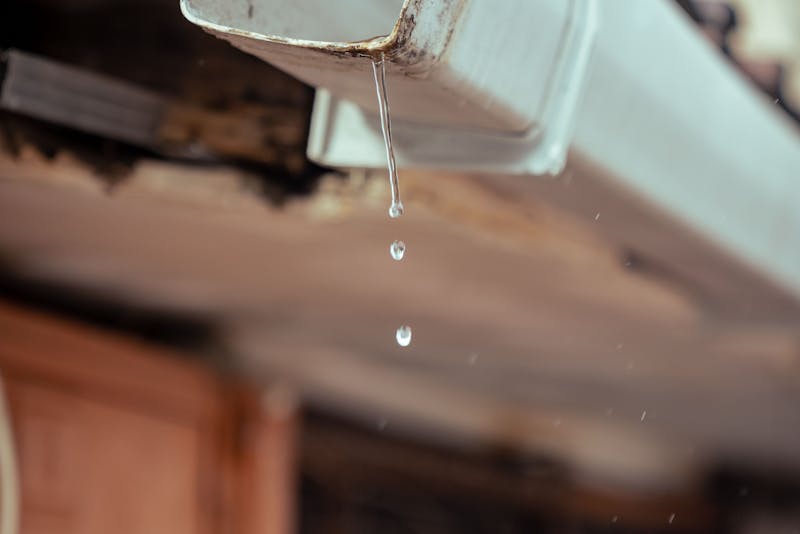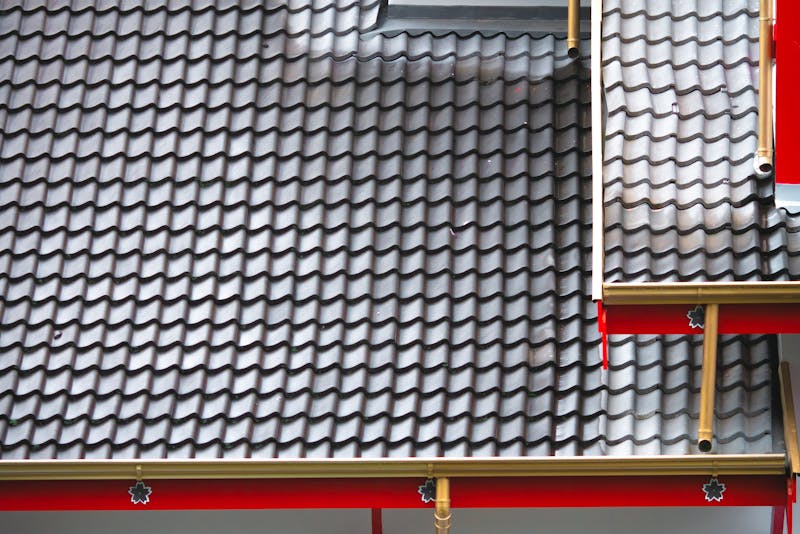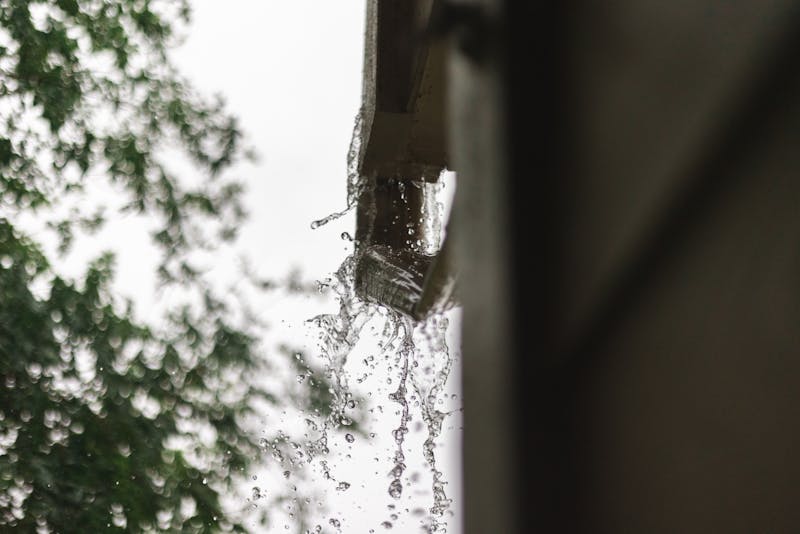- Proper rain gutter installation protects your home from foundation damage, soil erosion, roof issues, and exterior deterioration.
- Choosing the right gutter material (aluminum, vinyl, steel, or copper) impacts durability, maintenance, and long-term cost.
- Seamless gutters offer fewer leaks and better performance than sectional gutters, though they require professional installation.
- Correct sizing, slope, and downspout placement are crucial for preventing overflow and ensuring efficient drainage.
- Hiring a qualified, licensed professional with experience and solid warranties reduces the risk of poor installation or costly repairs.
- Add-ons like gutter guards, splash blocks, and extensions improve performance and reduce long-term maintenance.
Rain gutters play a critical role in protecting your home from water-related damage, yet many homeowners only think about them once they fail. Whether you’re replacing old, sagging gutters or installing a completely new system, understanding how rain gutter installation works will help you make informed decisions, avoid costly mistakes, and choose the right contractor. From materials and costs to design, sizing, and professional installation standards, this guide breaks down everything you need to know before hiring an expert for the job.
Below, you’ll learn how gutters actually protect your home, what to consider when selecting materials, how installation is done, and how to tell if your contractor is following best practices.
What Is the Purpose of Rain Gutters and Why Do They Matter?
A properly functioning gutter system is more than just a line of metal hanging from your roof. It’s part of your home’s overall drainage structure, designed to guide rainwater away from vulnerable areas safely. In this section, we’ll explore the core role gutters play in protecting your home and why installing them correctly is essential.
Before you hire a professional, having a clear understanding of the purpose of gutters will help you evaluate whether your home is adequately protected and what improvements may be necessary during installation.
Why Your Home Needs a Reliable Gutter System
- Prevents soil erosion around your foundation
- Minimizes the risk of basement flooding
- Reduces water pooling around landscaping
- Protects siding, windows, and fascia boards from moisture damage
- Prevents mold growth and wood rot
- Extends your roof’s lifespan
How Gutters Work With Roofing and Drainage
Gutters are positioned at the edges of your roof to catch rainwater as it flows off. They channel water through downspouts, directing it several feet away from your home. When installed correctly, this prevents water from seeping into your foundation, creating pressure against basement walls, or damaging exterior walls.
How Do You Know If Your Home Needs New Gutters?

Before investing in rain gutter installation, homeowners should know how to evaluate their existing gutter system. This section provides an introduction to the signs that indicate repair is no longer enough, and replacement becomes necessary.
Recognizing these signs early can help you avoid severe water damage and unnecessary spending. A new gutter system isn’t always required, but ignoring the warning signs can lead to issues that cost significantly more than a full gutter replacement.
Common Warning Signs
- Visible cracks, gaps, or holes
- Frequent clogging even with regular cleaning
- Peeling paint or rust on gutters
- Water marks on siding
- Pools of water near your foundation
- Sagging or pulling away from the roofline
- Mold or mildew around the fascia or soffit
When Repairs Are No Longer Enough
You may choose to replace your gutters if the system is older than 20 years, has frequent leaks, or no longer aligns properly with your roof’s slope. If the fascia boards are rotting or your gutters constantly overflow during storms, a new system is usually the safer and more cost-effective solution.
Types of Gutters: Which Material Is Best for Your Home?
Choosing the best gutter material is one of the most important decisions during installation. This section explains the differences in durability, maintenance needs, and cost. Not all gutters are created equal, and the right material depends on your home’s climate, budget, and long-term maintenance expectations.
Aluminum Gutters
- Affordable
- Rust-resistant
- Available in many colors
- Easy to install and maintain
- Moderate lifespan
Vinyl Gutters
- Lightweight and low-cost
- Easy for homeowners to install
- Not ideal for extreme temperatures
- Shorter lifespan than metal alternatives
Steel Gutters
- Durable and strong
- Available in galvanized and stainless-steel options
- Resistant to warping and weather
- Require periodic painting to prevent rust
Copper Gutters
- Longest lifespan (up to 50 years)
- Adds high-end appeal
- Naturally corrosion-resistant
- More expensive and requires specialized installation
Choosing the Right Material for Your Climate
For coastal or humid environments, aluminum and copper are best. In very cold climates, steel gutters may perform better due to their strength. Vinyl gutters work best in mild climates but can crack in extreme heat or cold.
Seamless vs. Sectional Gutters: What Homeowners Should Know
Seamless and sectional gutters offer distinct benefits and drawbacks. This section explains why the choice between these two styles matters. Many homeowners assume all gutters are installed the same way, but seamless gutters are custom-made onsite, while sectional gutters are pre-cut and assembled. The right option depends on your home’s layout, budget, and the professional you hire.
Seamless Gutters
- Custom-cut for a perfect fit
- Fewer joints mean fewer leaks
- Smooth appearance
- Typically made from aluminum
- Must be installed professionally
Sectional Gutters
- More affordable upfront
- Available in vinyl, aluminum, and steel
- Easier for DIY installation
- More prone to leaks due to joints
- Works well for smaller homes
Which Option Lasts Longer?
Seamless gutters often last longer because joints are the most common failure points in gutter systems. If you want minimal maintenance, seamless is usually the better investment.
Understanding the Rain Gutter Installation Process
This section introduces homeowners to how professional gutter installation works. Professional installation ensures proper slope, spacing, support, and drainage, which helps the system last longer and perform better.
Step 1: Inspection and Measurement
The contractor evaluates your roofline, fascia, and drainage layout. Measurements are taken to ensure accurate cutting and fitting.
Step 2: Removing Old Gutters (If Needed)
Old gutters are detached carefully to avoid damaging fascia boards or roof shingles.
Step 3: Preparing Fascia and Installing Brackets
Proper bracket spacing (typically every 2–3 feet) prevents sagging. Fascia boards must be solid and rot-free.
Step 4: Cutting and Fitting Gutters
For seamless systems, gutters are cut on-site using specialized machinery. Sectional gutters are assembled piece by piece.
Step 5: Installing Downspouts
Downspouts are positioned for optimal drainage, usually directing water several feet from the foundation.
Step 6: Testing the System
Your contractor should run water through the gutters to ensure proper flow and slope.
How Much Does Rain Gutter Installation Cost?
Rain gutter installation costs vary depending on materials, home size, labor rates, and additional features. Having a realistic budget helps you avoid underestimating expenses or choosing low-quality materials to save money upfront.
Average Cost Per Linear Foot
- Vinyl: Low-cost range
- Aluminum: Mid-range cost and most common
- Steel: Higher due to strength
- Copper: Highest cost due to premium quality
Additional Expenses
- Downspout extensions
- Gutter guards
- Fascia repair
- Disposal fees
- Labor for complex rooflines
How to Get an Accurate Quote
Always request a written estimate that includes materials, labor, and removal of old gutters. Compare at least three contractors.
What to Look for When Hiring a Gutter Installation Professional

Finding the right contractor can make or break your project. Proper installation ensures long-term performance and reduces the risk of water damage and unnecessary future repairs.
Qualifications to Check
- Licensing and insurance
- Experience with your chosen material
- References and reviews
- Warranty on labor and materials
Questions to Ask Your Contractor
- How long will the installation take?
- Do you install seamless gutters?
- What brands or materials do you recommend and why?
- Will you inspect the fascia before installation?
- Do you offer maintenance plans?
Red Flags to Avoid
- Unusually low estimates
- No written contract
- Pressure to pay upfront
- Lack of proper equipment
Why Proper Gutter Sizing and Slope Matter
Correct sizing and slope affect how well your gutters handle rainwater—especially during heavy storms. Many homeowners don’t realize how technical gutter sizing is, but professionals calculate dimensions based on roof pitch, rainfall intensity, and building layout.
Key Sizing Considerations
- Roof area and pitch
- Average rainfall in your region
- Downspout capacity
- Gutter width (commonly 5-inch or 6-inch)
Proper Gutter Slope
A slight downward slope ensures water flow. Typical slopes range from a quarter-inch for every 10 feet of gutter.
Signs of Incorrect Sizing
- Frequent overflow
- Standing water inside gutters
- Separation between gutters and fascia
Rain Gutter Installation: Best Practices Every Professional Should Follow
This section includes the main keyword as requested. Knowing what proper installation looks like helps homeowners recognize quality workmanship and avoid contractors who cut corners.
Industry Best Practices
- Install hidden hangers for better support
- Use corrosion-resistant fasteners
- Seal joints properly
- Ensure downspouts are properly secured
- Follow recommended bracket spacing
- Install splash blocks or extensions at the ground level
Why Standards Matter
Following installation standards helps gutters resist wind, heavy rain, and seasonal weather changes. It also reduces maintenance needs and increases system longevity.
Add-Ons and Upgrades to Improve Your Gutter System
Many homeowners choose to add enhancements during installation to boost performance and reduce cleaning. This section explains the benefits of optional upgrades.
Gutter Guards
- Keeps debris out
- Reduces cleaning frequency
- Works well with seamless gutters
Splash Blocks
- Prevents soil erosion below downspouts
Downspout Extensions
- Moves water farther away from your foundation
Rain Chains
- Decorative alternative to traditional downspouts
Heat Cables
- Prevents ice dams in cold climates
How to Maintain Your Gutters After Installation
This section introduces maintenance necessities and includes a variety of short paragraphs and bullet points. Proper care ensures the system performs well long after installation.
Basic Maintenance Tips
- Clean gutters twice per year
- Inspect downspouts for clogs
- Look for signs of sagging
- Remove debris after storms
- Check for leaks and cracks
When to Call a Professional
If you notice pooling water, frequent overflows, or sagging, a contractor may need to readjust your gutter slope or replace damaged sections.
Conclusion
Installing a high-quality gutter system is one of the smartest investments you can make to protect your home from water damage. From choosing the right materials to understanding the installation process and selecting a qualified contractor, being well-informed ensures long-term performance and fewer repair issues. With regular maintenance and proper sizing, your gutters can last for years while keeping your home’s foundation, roof, and exterior protected.




